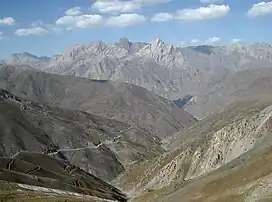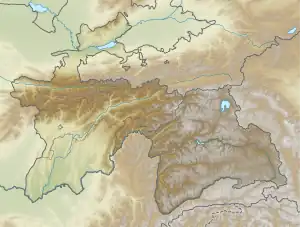Hisar Range
Hisar Range (Tajik: Қаторкӯҳи Ҳисор; Uzbek: Hisor tizmasi, Russian: Гиссарский хребет; Ukrainian: Ґаторкугі Гісор; Persian: رشتهکوه حصار; also known as Hissar, Hisor, or Gissar Range) is a mountain range in Central Asia, in the western part of the Pamir-Alay system, stretching over 200 km in the general east–west direction across the territory of Tajikistan and Uzbekistan.
| Hisar Range tg. Қаторкӯҳи Ҳисор uz. Hisor tizmasi ru. Гиссарский хребет | |
|---|---|
 View of the Anzob Pass across the Hisar Range with the Zarafshan Range in the background | |
| Highest point | |
| Peak | Khazret Sultan (former Peak of the 22nd Congress of the Communist Party) |
| Elevation | 4,643 m (15,233 ft) |
| Coordinates | 38°55′N 68°15′E |
| Geography | |
 Location in Tajikistan | |
| Country | Tajikistan, Uzbekistan |
| Parent range | Pamir Mountains |
Geography
The Hisar Range lies south of the Zarafshon Range, extending north of Dushanbe through Tajikistan's Hissar District of the Districts of Republican Subordination and reaching Uzbekistan at the north tip of Surxondaryo Region.[1] The highest point in the Hissar Range at 4,643 meters (15,233 ft) is located in Uzbekistan on the border with Tajikistan, just north-west of Dushanbe. Formerly known as Peak of the 22nd Congress of the Communist Party, the Khazret Sultan is also the highest point in all Uzbekistan. The Hissar Range is composed of crystalline rocks, schist, and sandstone, punctured by granite intrusions.[2]
Nature
Hissor Valley, which encompasses the Shirkent National Park is a 3,000-hectare (7,400-acre) reserve, which is expected to be expanded to some 30,000 ha (74,000 acres) in the coming years, has an unusually high concentration of sites of historical and scientific interest.[3]
See also
References
- Atlas of the Soviet Central Asian Republics, Geodesy and Cartography Authority, Moscow, 1988, in Russian.
- Big Soviet Encyclopedia, on-line edition, accessed April 16, 2008.
- Hissar Mountain Range, accessed December 1, 2016.
